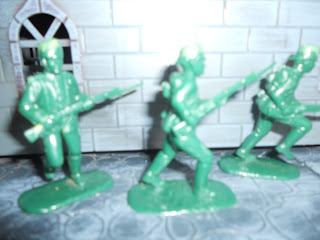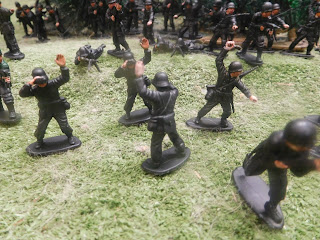The Awful Truth About Overcoats
No, this post is not about bad fashion. I am going to relate a few things about paints and overcoats for toy soldiers. The main focus here is on protective top coats.
Many of you, and myself included, brush or spray clear top coats over our precious figures, The intention is to protect them from damage and also to alter the finish, mat or gloss or something in between.
The reason I am currently thinking about this is the words a young Bunnings Warehouse employee told me: 'All enamel varnishes yellow'. My own experience is that this is especially so with mat enamel overcoats. It is most noticeable on whites and less apparent on non whites. This is not a complete disaster for although the whites do gradually yellow this can actually look more realistic; I mean how many soldiers in the field who wear white uniforms are going to be in bright whites? Not only are they going to get and appear disgustingly dirty but often the 'whites' are off-white in the beginning. I sometimes partially repaint these figures with purer white paint, often dry brushing the highlights or raised items like cross belts so there are a multitudes of shades.
Another thing is that paint colors don't remain the same either. Ever looked at an old metal hollowcast? The whites have yellowed or 'greyed'. When I repaint old battered hollowcasts I actually often mix a little buff color into the whites anyway; the reason is I like the look of old toy soldiers, although without the chips of paint missing. I aim for a semi gloss, which is how they generally come to look.
Now some acrylic sprays and artist fixatives specify that they are non yellowing. That is nice but here is my biggest warning. I know of examples where a collector (yes you Bob) spray varnished gloss figures to get a more mat finish. The problem was that an acrylic spray over a gloss ENAMEL paint of varnish is bad, very bad. The result is an unsightly crackling of the paint. You won't see it from a distance as they are fine cracklings or bubbling and it seems to have that result on some colors more than others. I'm not sure about this happening so much with brushons but I think so.
I thought I had learn this lesson well as it has happened to me a few times and I repainted parts of the figures. recently, though, I bought a semi mat spray and thought it good because non yellowing. I couldn't find anywhere on the can to designate whether it was enamel or acrylic. I tested it on an old repainted Britains civilian woman. I am fairly sure I used yellow enamel on the dress. I detected no crackling but just the degree of sheen I wanted. So then I sprayed my repainted Britains fusiliers. They cracked, most notably on the dark blue trousers. Obviously it was an acrylic spray and I should have known as it said 'non-yellowing' but that initial cautious 'test' was not sufficient. I am going to repaint the worst affected areas.
So I could avoid this by using acrylic paints only. The thing is that although they are my preferred paints sometimes I want a thick, robust enamel, especially on leads and especially where I am touching up on bare metal. I use gloss and semi gloss paints. Either I could leave them without a varnish or I could be careful to use an enamel varnish. (By the way, I seldom use enamels on plastics because the plastic is flexible and acrylics are a little bit more flexible than enamels so, hopefully, less prone to paint chipping. They still need an overcoat and so far I have found artists' fixative my favorite but I have not encountered, so far any bad reactions from either enamel of acrylic varnish over acrylic)
One other note; Some more rubbery plastics (such as the saddle cloths on Britains Detail medieval horses) react to enamel paints and remain sticky so they collect dust and hairs). If you undercoat first with PVA this seems to help. Then use acrylics.
In any case it is worth experimenting first with a couple of figures to make sure there are no problems.









Comments
Post a Comment